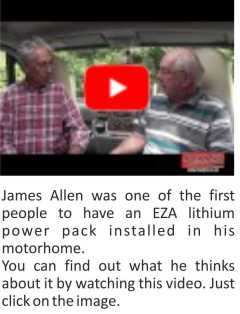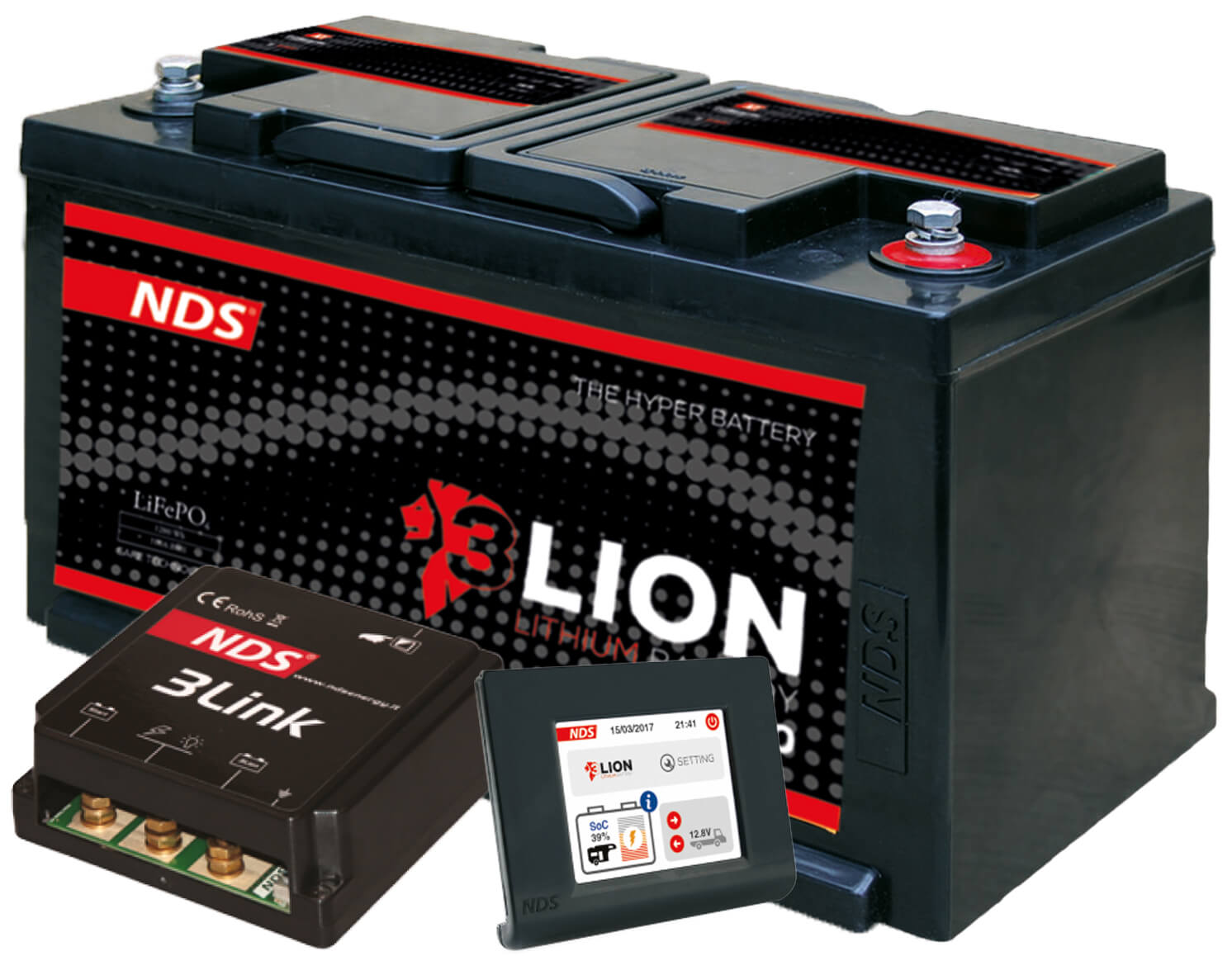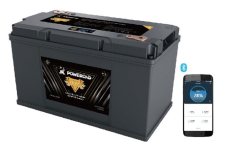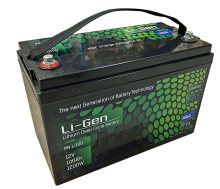Lithium Batteries: The Basics
Lithium batteries were invented and developed in the 1970s and 80s and have totally changed the way we use many electrical appliances. It’s only recently though, that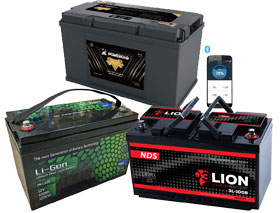 the advantages of lithium battery technology have begun to be available to motorhomers, caravanners, boaters and anyone who relies on 12V batteries for powering appliances.
the advantages of lithium battery technology have begun to be available to motorhomers, caravanners, boaters and anyone who relies on 12V batteries for powering appliances.
The difference in performance between a lithium battery and a traditional lead-acid battery is so great that anyone who is serious about staying “off-grid” in their vehicle or boat really has to consider installing one. It can only be a matter of time before lead-acid batteries are consigned to the proverbial dustbin of history.
Let’s get one thing clear to start off with: there are several different types of lithium battery and the ones that are used as auxiliary / leisure batteries are very different indeed from those used in mobile phones and cordless electric tools. Lithium batteries have a reputation for catching fire without warning but the batteries that we are looking at here are completely safe in normal use. These are lithium iron phosphate batteries, often referred to as LiFePO4 batteries and here are some of their advantages over traditional lead-acid batteries:
- Voltage remains constant for much longer during discharge.
- Much higher charging rate and so faster charging – varies according to the charging system used.
- Can be discharged quickly without damaging the cells, making them ideal for use with inverters.
- Can be discharged as much as 95% on average without damaging the battery.
- Thousands of charging cycles compared to just a few hundred from a typical lead-acid battery.
- Very low rate of self-discharge means they can be left unattended for months.
- Zero maintenance required.
- Approximately 40% - 50% lighter than a good quality lead-acid battery with a similar Ah rating.
- Very safe, with no toxic fumes or liquid and no risk of fire in normal use.
- The ability to charge quickly from the vehicle’s engine can remove the need for a generator or fuel cell.
- Can be used in almost every situation where a lead-acid battery is being used to power appliances in a motorhome, campervan or caravan.
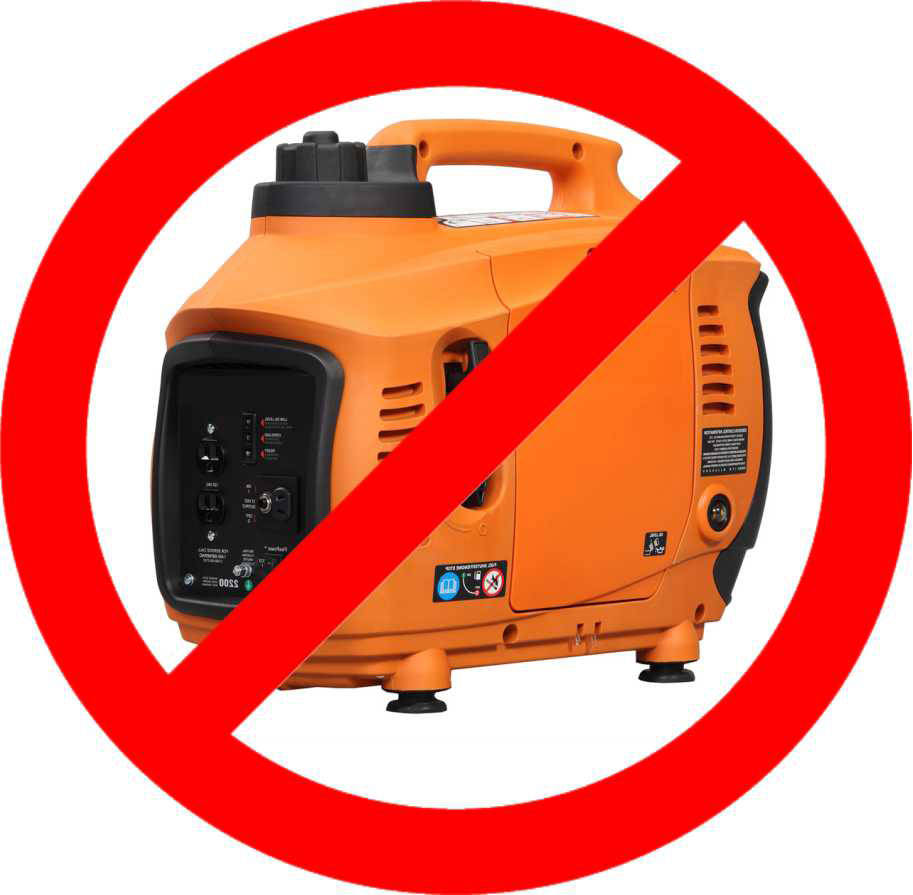
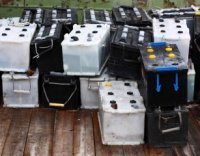 There is really only one disadvantage to having a lithium battery in your vehicle or boat and that’s the initial cost. This is likely to be significantly more expenisve than a lead-acid battery with a similar Ah rating. However, as a lithium battery can remove the need to ever use mains hook-up and can be charged and discharged several thousand times, for some people the purchase cost will be more than recovered during the battery’s lifetime.
There is really only one disadvantage to having a lithium battery in your vehicle or boat and that’s the initial cost. This is likely to be significantly more expenisve than a lead-acid battery with a similar Ah rating. However, as a lithium battery can remove the need to ever use mains hook-up and can be charged and discharged several thousand times, for some people the purchase cost will be more than recovered during the battery’s lifetime.
In addition, if you normally use a generator or fuel cell to charge a battery or operate 230V appliances, a LiFePO4 battery means that you probably won’t need either of these items. This saves money, inconvenience, excess weight and the necessity for additional fuel.
Let’s look at the advantages of LiFePO4 batteries in more detail:
1) Voltage remains constant for much longer during discharge.
If you’ve ever been watching TV and the picture has suddenly vanished while the sound stays on, you’ve experienced one of the problems associated with lead-acid batteries. Even if the battery is far from discharged, the voltage can drop to a point where certain appliances won’t function as they should.
LiFePO4 batteries maintain their voltage throughout their discharge cycle, down to as low as 5% state of charge.
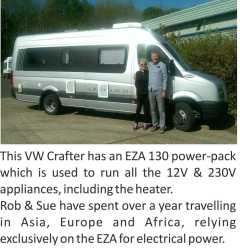
2) Much higher charging rate and so faster charging – within the limitations of the charging system used.
Lead-acid batteries don’t respond well to being charged quickly. It can be done but, depending on the battery and the charging method, it can take many hours to fully charge a 110Ah battery. Charging lead-acid batteries quickly can also damage them.
Because LiFePO4 batteries are able to accept a high rate of charge - over 100 Amps in some cases - they can be charged much more quickly. Even when it’s almost fully discharged, a LiFePO4 battery can be safely charged up again much faster than a lead-acid battery. Just running the vehicle’s engine for 20 minutes or so can put many hours worth of charge back into the battery.
The charging rate is dependent on the vehicle’s charging system and will vary according to how the charging system is set up. It’s a good idea to avoid discharging a lithium battery completely. This will help to maximise a battery’s useful life.
3) Can be discharged quickly without damaging the cells, making them ideal for use with inverters.
Discharging lead-acid batteries quickly is even worse for them than fast charging. It can cause the plates in the cells to deform and, if done frequently and at a high discharge rate, can dramatically shorten a battery’s life.
LiFePO4 batteries respond well to fast discharging with no adverse effects. This makes them ideal for use with inverters, especially when the appliances to be powered draw a lot of current: coffee machines, induction hobs, microwave ovens, hairdryers and toasters for example. This ability to reliably power 230V appliances without the need for mains hook-up is one of the main reasons that people install lithium batteries.
4) Can be discharged approximately 95% on average without damaging the battery*.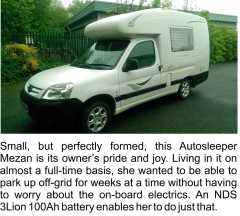
When a lead-acid battery gets to 50% state of charge, the voltage will usually drop to a point where appliances will not work as they should. With a lot of batteries – depending on the type, the quality and the condition - this can occur well before the battery is at 50% S.o.C. So, although a battery is rated at 110Ah, it may only give a useable 55Ah which, for many people may be what they would use during the course of a day, especially in the winter.
Even when a LiFePO4 battery is discharged to well below 50%, it will continue to provide a high enough voltage to ensure that appliances operate correctly. *When it’s been discharged by approximately 95%, a LiFePO4 battery with a good Battery Management System (BMS) will automatically shut down. However, to maximise useful life, it’s recommended that lithium batteries are not continually discharged much below 50%.
5) Thousands of charging cycles compared to just a few hundred from a typical lead-acid battery.
Depending on how a lead-acid battery is designed, manufactured and used, it may have a cycle life (the number of times it can be discharged and charged) of several hundred or far fewer. The way a battery is used makes a huge difference to cycle life and the same make and model of battery could work well for many years in one vehicle and just a few months in another.
LiFePO4 batteries have a cycle life in the thousands and, again, the way the battery is used will have an effect. Also, of course, some LiFePO4 batteries are made with better quality cells than others and will have a greater cycle life. For most people, a LiFePO4 battery will last longer than the vehicle they’re using it in. For example: using 50 Amps per day, 365 days per year, a 100Ah LiFePO4 battery can be expected to work efficiently for at least 11 years. Use it for only six months of the year and it should last for well over 20 years. Note that constant heavy discharging will reduce the useful lifetime of the battery.
6) Very low rate of self-discharge means they can be left unattended for months.
If you leave a lead-acid battery unattended, even for a few weeks, you may well go back to it to find that it’s flat. This is not only inconvenient but probably expensive too as a battery that’s left in a discharged state will suffer from sulphation, leading to damaged cells and an inability to hold a charge.
The discharge rate of LiFePO4 batteries will vary according to how the battery is designed but, as a rule, LiFePO4 batteries discharge much more slowly than lead-acid batteries: 3% per month on average. This means that a fully charged lithium battery can be left in place for months without losing a significant amount of charge. So you never need to worry that you’ll be faced with a flat battery.
LiFePO4 batteries work in a completely different way from lead-acid batteries and don’t suffer from sulphation. However, it’s not recommended to leave a LiFePO4 battery in a discharged state as this could shorten the battery’s useful life. Ideally, lithium batteries should be stored with a state of charge between 50% - 80%. The more gently you treat a lithium battery, the longer it will perform efficiently.
A good lead-acid battery being used as a leisure battery should be regularly checked to ensure that electrolyte levels are correct (except for AGM and gel types) and that there’s no corrosion.
LiFePO4 batteries are completely maintenance-free.
8) More options for positioning the battery in the vehicle.
With the exception of AGM and gel types, lead-acid batteries have to be mounted with the top of the battery uppermost. This can make lead-acid batteries difficult to install in certain situations.
Lithium batteries can be installed in any position except upside down. And, because we have a range of models from 20Ah to 150Ah, one of our batteries can be installed in any motorhome, campervan or caravan.
9) Approximately 50% lighter than a lead-acid battery with a similar Ah rating.
Lead is heavy and, the better the battery, the more lead there will be in it. This is one of the major disadvantages of lead-acid batteries, no matter what the application.
LiFePO4 batteries weigh 30% - 50% of what a lead-acid battery with a similar Ah rating would weigh. And, because you can use almost all the energy in a lithium battery, the weight saving can be huge. 2 x 100Ah lithium batteries are roughly the equivalent of 4 x 100Ah lead-acid batteries but the difference in weight can be 60Kg or more.
10) Very safe in normal use with no toxic fumes or liquid and no risk of fire in normal use.
If lead-acid batteries were invented now, they would be forbidden on health & safety grounds. They’re full of lead which is poisonous, and acid which burns. And they can explode! Some countries have considered banning them but, as there has been no alternative, that hasn’t happened.
LiFePO4 batteries are completely safe when used correctly. They are non-toxic, they don’t give off dangerous fumes and they cannot explode or catch fire.
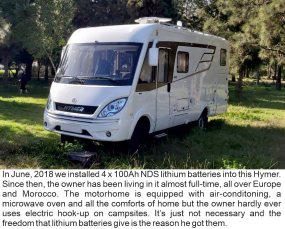 11) The ability to charge quickly from the vehicle’s engine can remove the need for a generator or fuel cell.
11) The ability to charge quickly from the vehicle’s engine can remove the need for a generator or fuel cell.
Generators are often used to both charge a leisure battery and to provide 230V as well. But generators have many disadvantages as anyone who’s used one or had to listen to someone else’s will know. Fuel cells are excellent for charging lead-acid batteries but they are very expensive, take up space and require the use of special fuel which is expensive, often difficult to obtain, hazardous and heavy.
A LiFePO4 battery gives the advantages of both generators and fuel cells. It can be charged simply by running the vehicle’s engine and charging is many times faster than even the best fuel cell. If you want to run 230V appliances, an inverter can do the job just as efficiently as a generator and without the inconvenience and noise!
12) Can be used in almost every situation where a lead-acid battery is being used.
Lead-acid batteries have been developed to the point where there’s a range of models to suit most applications. But, whatever the type of lead-acid battery, it will have the unavoidable disadvantages described previously.
There are many different types and models of lithium batteries, but here we are only referring to leisure / auxiliary batteries. Whatever the Ah capacity of the batteries you need, there is probably a LiFePO4 model to suit. Batteries can usually be joined together in parallel to create a battery bank that’s big enough even to run air-conditioning systems.
All LiFePO4 batteries offer the same advantages but the various models from different manufacturers all have their own unique characteristics. But, there’s one thing that every lithium battery needs: a BMS or Battery Management System. A BMS is essential if a LiFePO4 battery is to perform correctly and achieve its estimated cycle life. In most cases, it’s built into the battery case and it will help the battery work correctly and protect it from damage.
The way a LiFePO4 battery is installed in a vehicle will always affect the rate at which it’s charged from the alternator. Just dropping one into a vehicle to replace a lead-acid leisure battery will give many advantages but won't permit the rapid charging that a full installation would give. To get the most out of a lithium battery or batteries involves changing the way the leisure battery is charged and usually requires new cabling, special charging equipment and more. It can be expensive but, once it's done, it can completely change the way you use your vehicle and you may never have to buy another leisure battery!
At RoadPro, we have a range of LiFePO4 batteries to suit just about every requirement. Whatever your vehicle or boat, we can help you get a system that will free you from the hook-up lead. We really mean it when we say that you may never have to hook up to the mains again: ever!
NDS 3Lion Batteries
The 3Lion range of LiFePO4 lithium batteries from NDS is designed specifically for use in motorhomes, campervans, caravans and other vehicles. Battery sizes include 20Ah, 30Ah, 50Ah, 100Ah. Batteries over 100Ah can be used with a 3Link system, a battery-to-battery charger or simply as replacement batteries. For fast charging, the 3Link unit is ideal for use in most Ducato-based vehicles, connecting to the existing system and ensuring maximum performance with a charging current of up to 75 Amps.
At 190mm, the NDS 100Ah model is no higher than a standard European 110Ah lead-acid battery, making it possible to install the battery under many vehicle's front seats. We recommend 3Lion 100Ah batteries for all applications and especially when height is critical. Up to six 3Lion lithium batteries can be connected in parallel.
Poweroad Infinity Batteries
Manufactured by one of the leading Chinese battery companies, Poweroad Infinity batteries have a number of special features. There are two 100Ah models, one with a built-in heater that allows the battery to be charged even when the ambient temperature is as low as -20°C. Both models have an on/off switch which is useful when the battery is left unattended for a few weeks or even months. With a continuous discharge rate of 150A, Infinity batteries are ideal for use with appliances such as induction hobs and coffee makers which have a high power demand. Up to four Poweroad Infinity batteries can be connected in parallel but, because of the way the BMS's work, correct installation is essential. Please see the installation information on the Poweroad Infinity webpage.
Another feature of the Poweroad Infinity models is the Bluetooth connection which enables you to see exactly how the system is performing on a tablet or smartphone. Connection is simple thanks to a QR code on the battery itself.
Li-Gen Batteries
Li-Gen batteries are made in Ireland and represent great value for money. There are two models, a 100Ah budget-priced battery and a unique 150Ah battery in a European standard low case which will fit under the front seats of many motorhomes and campervans. (Available in August, 2021.) Both batteries have a continuous discharge rate of up to 100 Amps and a recommended charge rate of up to 50 Amps. Li-Gen batteries come with a six-year warranty.
We recommend Li-Gen lithium batteries when an installation requires two batteries to be connected in parallel and when the batteries do not need to go under a front seat.
Full information on all these LiFePO4 batteries can be found on the RoadPro website.
Equipment to make the most of lithium batteries:
All LiFePO4 batteries offer advantages over lead-acid ones but the various models from different manufacturers all have their own unique characteristics. Just replacing a lead-acid battery with a lithium one will be enough for some people but, to get the maximum benefit from a lithium battery needs additional equipment such as what you see below. RoadPro has a wide range of products designed to get the best out of any LiFePO4 lithium battery.
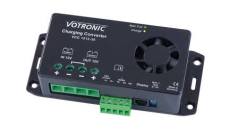 Battery-to-battery chargers
Battery-to-battery chargers
If you want to charge a lithium battery quickly when the vehicle's engine is running, you'll need a specialist piece of equipment: either a battery-to-battery charger or an NDS 3-Link system. You'll probably need to upgrade the vehicle's wiring to cope with the additional current - up to 90 Amps or even more. RoadPro has a range of battery-to-battery chargers from Votronic, NDS and CTEK, with charging rates from 20A to 90A. Which one is best for your installation depends on the batteries you have and how quickly you need them to be charged.
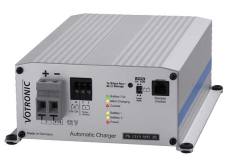 Mains-operated battery chargers
Mains-operated battery chargers
If you're using a lithium battery in a vehicle that already has a built-in 240V charger, you may not need a separate mains charger. Check that the charger is designed for wet or gel lead-acid batteries and, if you want to err on the side of caution, select the gel setting. Do not use an AG setting if there is one because the output voltage could exceed 14.4V and that could damage the battery.
Using a charger with a dedicated LiFePO4 setting will ensure that the battery is charged correctly in all conditions and, if you get one with a high output, will charge the battery more quickly than any built-in charger. We recommend chargers from Votronic.
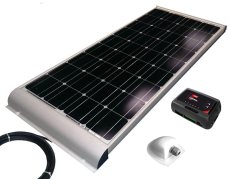 Solar panels and regulators
Solar panels and regulators
If there's room on your vehicle for one or more solar panels, we always recommend installing them. We have a wide range from NDS which includes panels to fit most requirements. With a good quality MPPT regulator, a solar power system can help to keep your batteries topped up, even when the weather conditions are less than ideal. It's important to use a regulator which will stop charging when the battery is at 100% state of charge and which can recognise what kind of charge is needed at all times. RoadPro recommends MPPT regulators from Votronic and NDS.
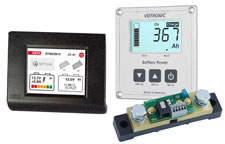 Battery monitors
Battery monitors
After they've had lithium batteries in their vehicles for a while, people often tell us that the best thing about them is that they never have to worry about them. Worrying whether you've got enough left in the battery to be able to get to the end of a film on TV or cook dinner in the microwave becomes a thing of the past. But, if you want to be able to see what's going on with your battery - the state of charge, voltage, Amps in and Amps out, you'll need a battery monitor. Some batteries come with Bluetooth and you can see this information on your phone but, as an alternative, a battery monitor can be installed. We recommend monitors from Votronic, NDS and NASA.
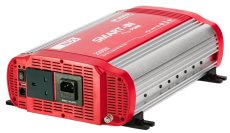 Inverters
Inverters
One of the biggest advantages of having a lithium battery in your motorhome, campervan or caravan is that you'll be able to use an inverter. An inverter changes 12V DC (or 24V) to 230V AC and many people install lithium batteries specifically to run appliances such as microwave ovens, toasters, coffee makers and hair driers. You’ll need an inverter if you want to run 230V appliances when no mains hook-up is available. RoadPro has inverters with outputs from 400 Watts - 3,000 Watts. Which one you need depends on what appliances you want to run. See the FAQs below for more information. We recommend inverters from NDS and Votronic.
Full information on all these products can be found on the RoadPro website.
FAQs about lithium batteries:
Q) Are lithium batteries safe to use in my motorhome / caravan / campervan?
A) At RoadPro we have fitted lithium batteries to hundreds of different makes and types of motorhome, caravan, campervan and boats. More and more manufacturers – both in Europe and the UK - are fitting them as an option or even as standard equipment and, when installed correctly, the batteries we use are safer than than lead-acid batteries.
Q) Would installing a lithium battery affect my vehicle's warranty?
A) Changing a lead-acid battery for a LiFePO4 unit should not affect the vehicle’s warranty as long as it’s installed properly.
Q) How do I choose which lithium battery to install?
A) It’s essential that, before installing a LiFePO4 battery, you know what you want to achieve from the installation. It’s then necessary to ensure that the battery you fit really is designed for the job. If you don’t do these things, you can waste a lot of money. The best way to ensure that you get what you need is to think about how you want to use electricity in your vehicle. Most importantly, do you want to use an inverter and, if so, what will you want to run from it? You’ll need to work out what your daily usage is likely to be, the maximum amount needed at any one time and how you will be charging the battery. Then, you can decide what size of battery bank you’ll need, how best to keep it charged, where to install it and what additional features you may want in the system.
Always use the services of a company that has experience of lithium batteries and knows how to install them correctly.
Q) Is it OK to just replace my existing (lead-acid) leisure battery with a lithium battery?
A) We don't recommend doing this but, as long as the lithium battery is from a reputable supplier, it's usually safe to do so and you'll immediately benefit from some of the advantages of lithium batteries. On the other hand, the battery will probably never be charged to its maximum potential nor very efficiently. For example, although a lithium battery can be charged at more than 60 Amps, without modifying the vehicle's wiring the charge rate from the vehicle's alternator may be nowhere near that. Not only that, charging a lithium battery with a mains charger or solar regulator designed for lead-acid batteries may not fully charge the battery and could result in a shorter useful life. For these reasons, we strongly recommend installing a lithium battery with appropriate charging mechanisms and cable.
Q) Will I need an inverter?
A) An inverter changes 12V DC (or 24V) to 230V AC and many people install lithium batteries specifically to run appliances such as microwave ovens, toasters, coffee makers and hair driers. You’ll need an inverter if you want to run 230V appliances when no mains hook-up is available. If you don't want to do that, you don't need an inverter.
Q) What sort of inverter should I get?
A) That all depends on what you want to run from it. Find out the total rating in Watts of the 230V appliances that you’ll be using at the same time. Then, add 25% to be on the safe side. If you just have a phone charger, go for an inverter with the lowest output you can find, measured in Watts. If you want to run a hair drier, a coffee machine or a microwave oven, you’ll need to consider a 2kW or even 3kW model.
There are two types of inverter: modified sine wave and pure sine wave. A pure sine wave inverter will produce electricity almost identical to what comes out of a 13A socket at home. This is essential for the proper operation of some appliances including coffee machines and electric toothbrushes but any appliance will run better on electricity from a pure sine wave inverter. Modified sine wave inverters are cheaper but won’t operate some equipment. Simple appliances like hair dryers or kettles will probably be OK but others won’t run at all, may be damaged or even catch fire. With a pure sine wave inverter, you can be certain that all your appliances will work correctly.
Q) Can I use the 230V sockets in the motorhome when I’m not on hook-up?
A) Yes, this can be enabled using a special inverter or separate switch which prevents mains hook-up and the inverter trying to supply the sockets at the same time. This kind of installation can be be tricky and we recommend that it's only done by speciailists.
Q) Is it really true that we can get away without ever using 230V hook-up?
Yes it is. As long as you can keep an eye on your electricity consumption and you can run your vehicle’s engine when necessary, a lithium battery will enable you to do everything you could do if you were on hook-up.
Q) What are the charging voltages for lithium batteries and how important are they?
A) To achieve maximum performance and useful life, it’s essential that a lithium battery is charged correctly. The charging requirements of lithium batteries are very different to those of lead-acid batteries. Different batteries need different voltages but, as a rule, a LiFePO4 battery should be charged at a constant voltage of no more than 14.4V or 14.6 depending on the battery. Charging at a lower voltage (14.2V for example) will do no harm and may extend the life of the battery but charging at higher voltages must be avoided by using suitable charging equipment. In particular, avoid using a charger which has a "desulphation" or "recovery" stage.
Q) Does it matter what alternator my vehicle has?
A) Almost any modern 12V alternator will charge a lithium battery efficiently as long as the output is between 13.8V and 14.4V. At lower voltages, the battery will not reach 100% state of charge but it will be so close that it’s probably not worth worrying about. Charging at a lower voltage can also help to increase a lithium battery’s useful life.
Q) What if my vehicle’s engine has a “smart” alternator?
A) Whatever type of leisure battery you have, if your vehicle’s engine has a “smart” alternator and you want to charge the battery efficiently, you’ll need to have a battery-to-battery charger installed. For lithium batteries, it’s essential that the battery-to-battery charger has a LiFePO4 setting.
Can I use a solar panel with a lithium battery?
Q) Yes, but it’s essential to make sure that the voltage regulator is suitable. As with the Votronic range, it should have a setting for LiFePO4 and this is what we would always recommend for maximum efficiency and long useful life. It’s not necessary and not a good idea to keep a lithium battery constantly on charge. Your supplier or installer will be able to advise further.
A) Do lithium batteries need special 230V chargers?
For fast, safe charging, a special LiFePO4 charger is the best way to keep a lithium battery charged. However, if your motorhome, caravan or boat is already equipped with a charging system, it will charge a lithium battery satisfactorily as long as it’s switched to a gel setting. If your vehicle is connected to mains hook-up, make sure that you disconnect it when the lithium battery has been fully charged. Do not leave the charger connected after the battery is at or near 100% state of charge and do not charge it when the battery’s temperature is below 0°C.
Q) How are lithium batteries affected by temperature?
A) As with lead-acid batteries, the performance of LiFePO4 batteries is affected by the ambient temperature. As a rule, lithium batteries can charge between 0°- +45° and discharge between -20°C - +60°C. If the temperature of the battery reaches 0°C, care must be taken not to charge it from the engine, a solar panel, mains hook-up or any other charging source. We recommend the use of temperature sensors with solar regulators and 230V chargers. RoadPro has batteries with built-in heaters which enable them to be charged when the ambient temperature is as low as -20°C.
Q) I’ve heard that there are different kinds of LiFePO4 battery? What are the differences?
A) LiFePO4 cells are of two types: cylindrical and prismatic. Prismatic cells are flat and rectangular and can have a higher energy density which basically means more energy in a smaller space. Cylindrical cells may, in theory, last longer but the way in which a battery is used has much more impact on its cycle life. In real life, the practical differences between cylindrical and prismatic cells are not worth worrying about.
Q) Can I use a lithium battery in my caravan?
A) Yes, we have supplied many systems to caravanners and we have specialist equipment to enable this.
Q) I always stay on campsites and hook-up to the mains supply. Do I need a lithium battery?
A) No!! Save your money and buy the cheapest starter battery that you can find.

In a nutshell, here are ten reasons why you should seriously consider installing a LiFePO4 battery in your vehicle or boat…..
- You want to be able to spend as much time as possible “off-grid”.
- You want to run a coffee maker, hair dryer, microwave oven, toaster or any other 230V appliance when you’re not on mains hook-up.
- You need to use medical apparatus in your vehicle and need to be certain that it will function correctly when needed.
- You’d rather use electrical energy than rely on LPG in your vehicle or boat.
- You want to save money by not having to pay for mains hook-up ever again.
- You don’t want to ever have to worry again about the lights, the TV or other 12V appliances going off because the battery “has died”.
- You want to save weight in your vehicle.
- You’ve had enough of lead-acid “leisure” batteries that only last a couple of years or so.
- You‘re tired of having to check your batteries, top them up and keep them charged even when they’re not being used.
- And finally, because LiFePO4 batteries last so long, they can actually save you money in the long run.
